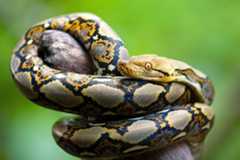python
Our editors will review what you’ve submitted and determine whether to revise the article.
python, any of about 40species ofsnakes, all but one of which are found in the Old World tropics and subtropics. Most are large, with thereticulated python (Malayopython reticulatus) ofAsia being the longest, with the largest adults measuring 7–8 meters (23–26.2 feet) in length, but there are reports from the island of Celebes (Sulawesi) dating to 1912 of an individual that measured 10 meters (32.8 feet) long.
Most pythons areterrestrial to semiarboreal, and a few, such as the green tree python (Morelia viridis) of Australia andNew Guinea, are strongly arboreal. Terrestrial pythons are regularly found near water and are proficient swimmers, but they hunt and eat almost exclusively on land. Larger pythons prey mainly on mammals and birds; smaller species also eat amphibians and reptiles. Pythons have good senses of smell and sight, and most can also detect heat. Pits lying between the lip scales have receptors that are sensitive toinfrared radiation and enable pythons to “see” the heat shadow of mammals and birds even during the darkest night. Prey is captured by striking and biting, usually followed by constriction. When swallowing prey, pythonssecrete a mucus that contains harmless trace amounts of venom proteins.
Pythons are egg layers (oviparous) rather than live-bearers (viviparous). Females of most, if not all, species coil around the eggs, and some actually brood them. Brooders select thermally stable nesting sites, then lay their eggs and coil around them so that the eggs are in contact only with the female’s body. When the air temperature begins to drop, she generates heat by shivering in a series of minuscule muscle contractions and thus maintains an elevated and fairly constant incubation temperature.

Old world pythons
Eight species ofgenusPython live insub-Saharan Africa and fromIndia to southernChina intoSoutheast Asia, including thePhilippines and theMoluccas islands ofIndonesia. Other relatedgenera inhabit New Guinea and Australia. Some Australian pythons (genusLiasis) never grow much longer than one metre, but some pythons ofAfrica (P. sebae),India (P. molurus), Southeast Asia andJava (P. bivittatus), New Guinea (L. papuanus), and Australia (L. amethistinus) regularly exceed 3 metres (10 feet). Despite their large size, some of these species survive in urban and suburban areas, where their secretive habits and recognized value as rat catchers par excellence serve to protect them. TheBurmese python (P. bivittatus) also occurs in large numbers in southernFlorida inNorth America, where it is considered to be a seriousinvasive species. The so-calledearth, or burrowing, python (Calabaria reinhardtii orCharina reinhardtii) ofWest Africa appears to be a member of theboa family (Boidae).
New world pythons
Taxonomists divide the family Pythonidae into either four or eight genera. The only nativeNew World python (Loxocemus bicolor) is classified as the sole member of the family Loxocemidae. It is an egg layer found in forests from southern Mexico toCosta Rica. Usually less than 1 metre (3.3 feet) long, it is reported to reach nearly 1.5 metres (5 feet). It seems to be predominantlynocturnal, foraging on the ground for a variety of small vertebrates.











